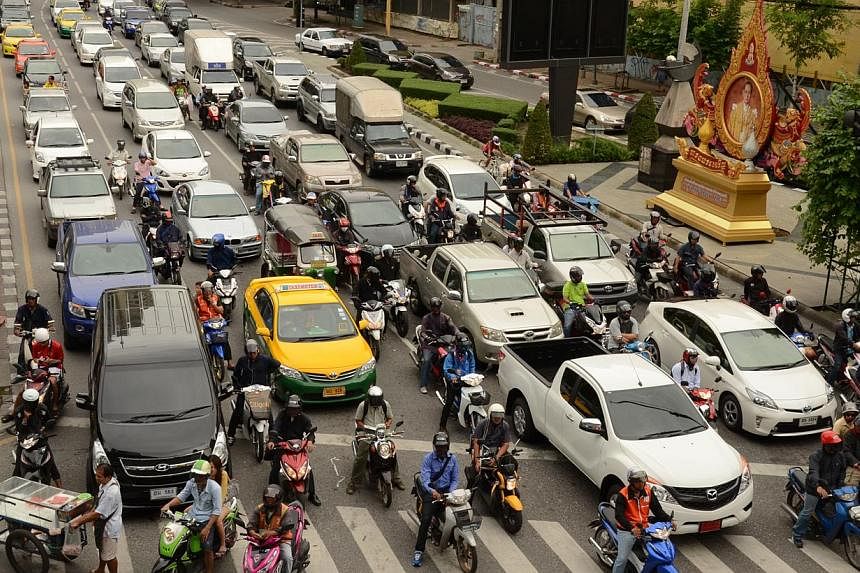Yet another around- the-world cyclist - this time, one with a Singapore connection - has had his attempt cut short, by being killed on Thailand's hazardous roads.
Chilean cyclist Juan Francisco Guillermo died when he was struck by a pickup truck in north-eastern Thailand last month. Mr Guillermo left behind his Singaporean wife, Ms Ng Poh Leng, and their two-year-old son, Lucas.
Ms Ng was cycling with Lucas at the time as well, but both escaped serious injury, according to news reports, which quoted a police officer as saying the road was straight and the cyclist was in his own lane. The driver has since been charged with careless driving resulting in death and injury.
In February 2013, two British around-the-world cyclists were killed in a road accident in eastern Thailand.
Indeed, Thailand has the most dangerous roads in Asia, said the World Health Organisation (WHO). According to its Global Status Report on Road Safety, 1.24 million people die every year in traffic fatalities. The Asian Development Bank calculates that 60 per cent of those fatalities occur in Asia.
And Thailand leads the region, with a rate of 38.1 road deaths per 100,000. It is followed by Malaysia (25) and Vietnam (24.7), and then China (20.5) and India (18.9). In contrast, the average worldwide traffic fatality rate is 18 per 100,000.
As all 10 Asean members continue their pursuit of greater integration and investment and the Asean Economic Community, traffic fatalities may well continue to grow - an unintended price of billions of dollars in infrastructure projects bringing more roads to the region, as well as growing numbers of vehicles - if there are no parallel investments in education and road and vehicle safety.
The WHO data reveals that fatalities occur disproportionately among the poor, young, cyclists, pedestrians and users of motorised two- and three-wheeled vehicles such as scooters and tuk- tuks, which are popular throughout South-east Asia.
It is an epidemic that disproportionately affects the middle-income countries in the region, those undergoing rapid development such as improved roads.
Hence, the situation, if not addressed, will get worse.
Rising incomes in Laos, Cambodia, Myanmar and throughout the region will lead to more motorised vehicles on the roads. WHO reported that between 2009 and 2013, the number of vehicles in South- east Asia increased 28 per cent from 168 million to 215 million.
But there are ways to prevent these deaths.
First, road projects - whether financed by development banks or government finances alone - must factor in, as part of an initial assessment and subsequent project development, the needs and the reality of the affected communities and their economic activities. This could well mean adding paths for pedestrians, cyclists and motorised vehicles other than cars and lorries.
Including such design features has had a major impact in decreasing road fatalities in North America and Europe, according to WHO. Developing Asia could well also benefit from such lessons learnt, balancing short-term costs with longer-term economic benefits of reduced road deaths.
Second, education components should complement infrastructure programmes. These could include emphasising safety measures such as helmets for motorcyclists and seat belts for passengers and drivers of motorised vehicles.
The roads themselves could incorporate better road signs, rumble strips and speed bumps, and passing lanes.
Budgets must also be allocated for maintenance and capital improvements.
Third, public-private partnerships should be encouraged as one way to augment limited government funds. Tolls are a common solution, providing user-based fees to help recover the costs of, and maintain, roads.
The not-for-profit sector also can contribute.
For example, the Bloomberg Philanthropies "Global Road Safety Initiative" seeks to reduce road fatalities through technical assistance from traffic safety organisations and media safety campaigns to decrease drink-driving, and encourage the use of helmets, seat belts and child restraints.
Bangkok, Bandung in Indonesia and Ho Chi Minh City in Vietnam are three of 10 cities selected to participate in the initiative, with each city receiving a portion of an overall US$125 million (S$174 million) programme budget.
For too long, developing Asia, including large parts of South- east Asia, has accepted the rising number of road deaths as a necessary price to pay for rapid development.
This need not be the case.
Financiers, developers and users of South-east Asia's growing road network must take to heart that projects should not only benefit those who use them.
They should also not put anyone in harm's way, whether an around-the-world cyclist or a lorry driver taking goods from a farm to the market.stopinion@sph.com.sg
The first writer, a former US ambassador to the Asian Development Bank, is an Asia Fellow at the Milken Institute. The second writer is a commentator on South-east Asia and an associate at advisory firm RiverPeak Group. S.E.A. View is a weekly column on South-east Asian affairs.

